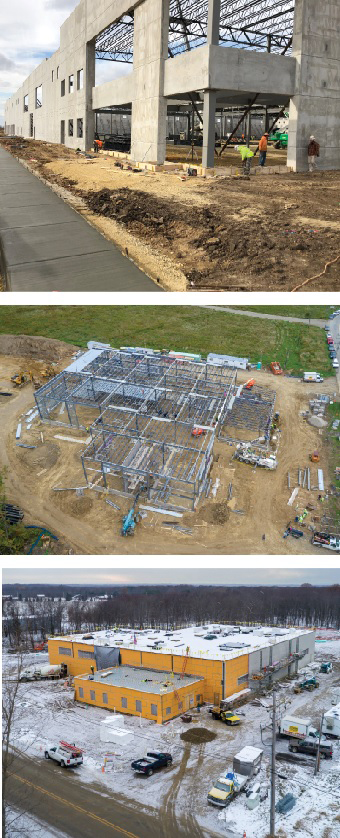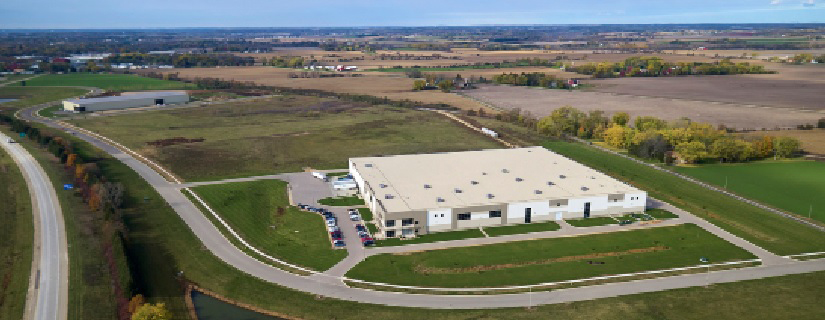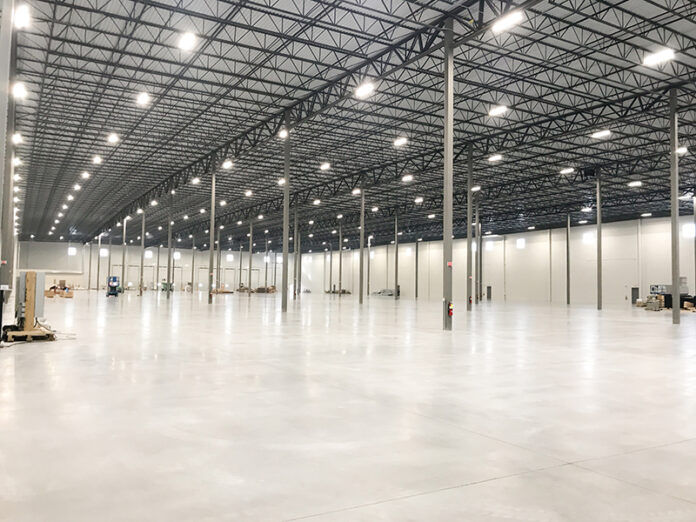by Liz Stevens, writer, Plastics Business
For blow molders and injection molders whose businesses are outgrowing their available space, building an additional facility is not a new project to be taken lightly. Molders invest countless hours in analysis, research and planning to inform a wise decision. They then expend more energy to choose a site, spec out the details, contract the necessary players, order the equipment, set the plan in motion and weather the inevitable construction delays and move-in glitches. Pride of ownership and a feeling of accomplishment are among the rewards for constructing a bright, clean new plant with the latest in technology and automation, along with confidence that one’s business now is equipped for whatever the future may hold.
The recent plant construction projects undertaken by Plastikos Medical and Schoeneck Containers demonstrate that taking the leap of faith to build a new facility can be a successful, rewarding experience. Plastics Business talked with Philip Katen, general manager and president at Plastikos, Inc., Erie, Pennsylvania, and Josh Kouba, vice president of engineering at Schoeneck Containers, Inc., New Berlin, Wisconsin, about the highlights of their recent from-the-ground-up plant construction projects.

The impetus to build an additional facility
In 2015, as custom injection molder Plastikos, Inc. was expanding its headquarters facility (8165 Hawthorne Dr.) to support its growing medical device customer base by adding ISO-7 certified cleanroom capacity, the company also decided to launch Plastikos Medical (8121 Hawthorne Dr.).
The company, founded in 1989, focuses on producing high-speed board-to-board connectors, micro pitch connectors, rugged/power systems, aerospace and industrial consumer devices, and medical devices. The company’s newest entity and most recent construction project, Plastikos Medical, produces medication delivery systems, surgical eye care devices, microfluidic pump components, digestive health devices and endoscopic devices, among other medical device parts and components. Plastikos was seeing steady demand from its medical-oriented customers, and it had more new customers in the pipeline. Having faith in these customers’ growth and success allowed Philip Katen, Ryan Katen and Rob Cooney to be confident about launching a new entity, purchasing land and investing in a new building and equipment.
“We looked at our existing customers and saw steady month-after-month production demand, with growth layered on top of that,” said Katen. “That reduced the risk of a new investment and put our minds at ease. And we are very well-diversified within the medical device side of our business, having multiple customers that span different sub-segments of the medical device industry. That also helped to reduce the risk profile.” Katen and his partners didn’t have to look far to find room for a new facility. “We purchased a piece of property just down the street,” he said, “literally a five-minute walk on a nice day from our headquarters.”
Meanwhile, in New Berlin, Wisconsin, Josh Kouba was running out of space at Schoeneck Containers. In business since 1972, Schoeneck Containers supplies blow-molded and injection-molded plastic containers for diverse consumer and commercial markets throughout the world. The company’s containers are used for food, beverage, personal care, household and industrial products.
“Like most blow molders,” said Kouba, “we looked at adding on, then adding some more machines and then adding on again. Well, we had done that, and we had become landlocked at our headquarters in New Berlin.” The company knew it could count on additional growth. “That is when we asked ourselves if it was time to look for an existing building because we can’t really add on here anymore? Or do we look for some green space to try to do this how we really want to do it?” Kouba and his team wanted to be gamechangers in the blow molding world and to assemble a lights-out blow molding facility. “We looked around and we found some land in the city of Delavan,” he said, about 40 miles south of New Berlin.
Location, location, location
Kouba knew what he wanted in a location for a new Schoeneck Containers facility. “We wanted to be far enough away from our headquarters that we could operate independently, but close enough to share resources and have ready access to the experts if we needed them,” said Kouba. “Another thing we wanted was to be a little further south, closer to Chicago, where we do a lot of business.” A location nearer Chicago, on the I-43/I-90 corridor would be convenient for local customers and helpful for supply chain issues. “The third thing we wanted,” said Kouba, “was rail spur access so that we could get resin via railcar.” A plot of land in Delavan met all of Kouba’s requirements.

The land that the Plastikos owners located for Plastikos Medical in Erie was one of the last vacant lots in the business park that housed Plastikos, Inc., and was located down the street. “Having the new facility located just a five-minute walk from the main Plastikos facility affords a lot of advantages,” said Katen. “We can utilize shared staffing and support services such as maintenance, process technician, quality technician and engineering support. These and other resources allow Plastikos Medical to be more efficient than it otherwise would be if it were located even 15 or 20 minutes away from our headquarters.”
Learn from the past, design for the future
For the Plastikos Medical 25,000 sq. ft. Phase I construction project – with design work starting in 2018, construction completed in 2019 and operations starting immediately after Labor Day 2019 – Plastikos’ mantra was “Learn from the past and build for your vision of the future.”
“Plastikos Medical rests on the foundation of the Plastikos headquarters design,” said Katen, “and it is a testament to the prior generation of owners. When they built the original facility, it was designed upfront with an eye to the future and the ability to expand.” The original facility was expanded three times between 1995 and 2015, always with an intentional mindfulness and effort to do things better, to be more efficient, add automation, incorporate better building methods and green systems, and create better operational flow. “With each expansion, we looked at taking it to the next level,” Katen explained. “What did we learn from the prior project, or what have we noticed as we started to use a new space that we could do a little bit differently, a little bit better, if we could do it over?”
Philip Katen, Ryan Katen and Rob Cooney collectively approached Plastikos Medical – Phase I with considerable experience and an understanding that here was a chance to do it better. “We were able to take a lot of good ideas and best practices that we had put into the medical wing expansion at Plastikos and implement them down the street at Plastikos Medical.” Katen said. “For instance, we upgraded and enhanced the building infrastructure and some of the building systems.” The upgrades included HVAC, insulation, electrical and lighting, and adopting green building best practices to improve energy efficiency. “The other big piece,” said Katen, “was that at Plastikos Medical, we pushed harder to automate even more processes to reduce direct labor requirements for production and to run very efficiently.”

Schoeneck Containers’ Delavan facility also was completed and put into operation in 2019. Kouba and his team were as thoughtful and forward-thinking during their design process as the team at Plastikos. “We used a number of resources and found key partners to really accomplish our vision,” Kouba said. This included many meetings upfront to determine details such as plant size, layout and infrastructure. “We also wanted to make sure we had rail car access, so part of the design process had to cover that angle. You can’t just put a rail spur anywhere; we had to branch off the main rail line and put a rail spur in. Our building site allows us to not only have a 250,000 sq. ft. facility, but to also have enough land next to the facility to build another plant of that size or larger. The rail spur specifically was designed to go across both parts of the land to accommodate future growth.”
By using rail cars for resin delivery, Kouba can receive 180,000 to 200,000 pounds of resin in one car vs. a maximum of 20,000 pounds in a bulk truck. One rail car delivery takes the place of nine or 10 bulk truck deliveries and also cuts the emissions from those truck deliveries. “If you don’t have rail car access,” said Kouba, “then you have a bunch of silos with bulk trucks arriving all day every day to empty their trucks into your silos.” The placement of the rail spur dictated where the back of the facility would be located, and Kouba then considered how to design the best process flow and material flow within that building configuration.
Like Katen, Kouba had learned from prior expansions and construction. “We learned a lot from New Berlin,” he said, “from the experience of adding on, being landlocked and adding on more.” He also took the wish list items from New Berlin and incorporated them into the design for the Delavan facility. Kouba ticked off some of the list – climate control, bright lighting, natural light. “We’ve put in some very large windows in our Delavan facility – almost floor to ceiling – on the manufacturing side,” said Kouba, “It was awesome to bring those wish list items to life.”
Incorporating elements for the next set of advances
Schoeneck Containers’ new facility is chock full of forward-thinking elements in infrastructure, layout, automation, technologies and auxiliaries. In addition to purchasing enough land for a second facility in the future, Kouba prepped the infrastructure of the first building for future expansion. “We tried to set the facility up as a plug-and-play facility,” he said. “We did preemptive things like putting an extra pad outside for the next electrical service that we will someday need. We ran conduits from that electrical service to the opposite end of the building, under the concrete, for pulling wire when new machines are added. We added bus stops so all you do is put a bus plug on it, pull your wire, connect your machine and away you go.”
Kouba also planned and built now for tapping solar power in the future. “We positioned the facility so that we have good exposure to the sun both east and west,” said Kouba, “and a very nice flat roof where, eventually, we will put up panels for solar power.” Solar panels will not produce enough power to run all of the blow molding machines but should generate enough juice for non-production electrical needs.
In the back room, Kouba set up air compressors and the chiller system, leaving space to add another chiller module and another air compressor. “We know the tipping points,” he said. “If we want to add a number of machines, we know that we also have to add another chiller module and another air compressor.” The ability to plan and build for that kind of future expansion, Kouba said, is a real luxury compared to being in a landlocked facility with limited space and no opportunity to prep now for power or air requirements down the road.
The air compressors do double duty, and the chillers are state-of-the-art. “The air compressors are air-cooled,” said Kouba, “and we vent them outside, but in the winter, we use louvers on our ductwork to direct the heated air into the back room and the warehouse portion of the building.” The compressors always are running to provide compressed air to blow bottles, and using the compressors heat by-product in the winter to supplement the heat in the facility cuts down on the load for rooftop heaters and space heating.
Kouba and his team chose to add a chiller system that includes a closed-loop adiabatic fluid cooler. “The cooler is just outside on a slab,” explained Kouba, “and being in Wisconsin allows us to leverage free cooling in the winter months, roughly from mid-October to mid-April, instead of having the chiller system run full-out year-round. One year, it was cold enough up until April 13.” In this adiabatic fluid cooler, water and glycol (to prevent freezing) flow through and are cooled down by the ambient air; when the flow returns to the chiller system, a separate module filters out the glycol so the process water for the machines is glycol-free.
At the new Schoeneck plant, all of the grinding and material handling is “behind the curtain.” “We do these jobs in separate rooms off the main production floor to keep the noise level and the dust way down,” said Kouba. “For anyone who has visited a blow molding facility, a visit to the new Schoeneck plant will be the nicest one they have seen. That was the goal for us: to make the plant as lights-out and as technologically advanced as possible, and to build a game changer in this industry.”
Schoeneck invested in resources that help connect and support its larger multi-plant operation. “For example,” explained Kouba, “with DELMIAWorks, we have a multi-plant setup that allows us to talk to both facilities remotely and in real-time to understand inventory and production requirements and facilitate production scheduling and inventory control.”
The Plastikos project included several manufacturing advancements and energy-efficient elements. Katen explained that, while some of the plant’s injection molding presses are specialized in automation or features, “in general, our presses, auxiliaries and a lot of the automation we have invested in are quite flexible and versatile, to the point that multiple customers, multiple applications, all can utilize the same equipment, automation and auxiliaries.” That kind of designed-in versatility lowers the risk profile when embarking on the construction of a new facility and also goes hand-in-hand with the diversification that Katen wanted. “If, for some reason, this medical application or that newly-launched device doesn’t take off or if it sees an initial spike in demand but then falls off precipitously in production quantity, then other applications, other customers or other projects can be plugged in quickly to fill the void or tap the available capacity.”
Katen said that his partners, their architect and engineers incorporated many “green” elements into the design for Plastikos Medical. “We included LED lighting with occupancy sensors throughout the new facility, a closed-loop water chiller system to minimize our water consumption, additional/higher R-value insulation and low-flow fixtures in the restrooms.” The facility features building and material systems for collecting and grinding 100% of its plastic scrap waste and works with plastics recycling companies that source regrind for other plastics companies.
Katen feels, though, that one overarching design choice delivers the company’s most impactful innovations. “In terms of significantly reducing Plastikos Medical’s extended footprint on the planet,” said Katen, “our vision for the future of advanced domestic manufacturing incorporates advanced automation systems to run more effectively, more efficiently and with significantly less direct labor. With a highly efficient, low direct-labor operation,” Katen explained, “we can run 24/7 with significantly fewer people at Plastikos Medical compared to Plastikos’ headquarters, which is actually highly automated and very efficient in its own right.”
Katen’s equation: fewer people at the plant during the day, at night and on weekends equals a big reduction in natural resources consumed (fewer lights turned on, less water used in the restrooms and breakroom, less heating in the winter, less cooling in the summer). “And then taking that environmental footprint one step further,” said Katen, “the fact that we can run effectively and efficiently with fewer people on the team means that fewer people are driving to and from the plant each day, thus cutting the use of natural resources outside of the workplace.”
Overcoming construction challenges
In Katen’s estimation, the construction project at Plastikos Medical went very well, and he credits a terrific contractor, team of construction workers and all of the skilled tradesmen who worked on the project, as well as excellent partnerships with the company’s press manufacturer and its auxiliary equipment suppliers.
“Throughout the process, there were some challenges with delivery of materials, such as structural steel and rebar, with promised delivery dates getting pushed out a week or two, and then that turned into a month or two,” Katen said. There also were some other “random” delays in the construction supply chain, such as in getting the chemicals required for roofing insulation. These challenges, along with some labor shortages, primarily impacted the general contractor and the subcontractors. Overall, though, Katen felt fortunate with the project’s success. “There have been challenges, hiccups, lessons learned and problems but that is what we are here for,” said Katen. “So you come in, roll up your sleeves, dig in and figure a way to solve the problem.”
Kouba also reported mostly smooth sailing during the Schoeneck construction. “All things considered,” he said, “I think it went about as smooth as we could have expected. I give a lot of credit to our CEO Tom Frank. He and I really spent a lot of time trying to plan this out, to look at material flow and to make sure that we chose the right partners to help us execute this.” Kouba said the pair spent more time planning, choosing equipment and designing for future growth than it took for the construction company to put up the facility. “With all of the up-front planning and meetings that we had,” said Kouba, “we were able to avoid any serious complications.”
On the horizon
With these construction projects behind them, Katen and Kouba are looking ahead to a bright and busy future. For Katen and Plastikos Medical, Plastikos Medical – Phase I now is home to 10 medical molding machines running production 24 hours, seven days a week in the ISO-7 cleanroom. Phase II of the site’s building project is slated to be completed this spring, adding an additional 25,000 sq. ft. of operating space. “The Plastikos Medical – Phase II expansion,” said Katen, “will support 15 additional medical injection molding machines, all in an ISO-7 cleanroom, along with the corresponding auxiliary equipment and even more automation than we incorporated into Phase I.”
At Schoeneck Containers, Kouba is ready for whatever comes next. “When we decided to take the leap and build a new facility from the ground up, we knew it was a bit of a risk, but it has been a game changer for us,” he said. “When we bring in customers, they see a bright, inviting facility and they feel good about the quality of the products we produce.” Customers also see that Schoeneck has room to grow. “They may have a growth opportunity,” said Kouba, “They might say ‘Hey, it’s 20 million units a year that we need.’ We can be ready to grow with them, to tool it up and get new equipment, knowing that we have the infrastructure in this facility to support it. And the land that we have next to us allows us to even take it to the next level. We could build a warehouse itself and keep this as all manufacturing, or we could replicate this same facility in the next building.”
For Kouba and Katen, their planning and hard work have been rewarded; they have bright, clean new plants with the latest in technology and automation. They also have confidence that their businesses now are equipped for just about anything the future may hold.





